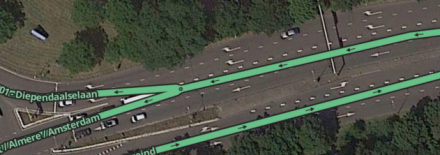
General
Resources
Notice : Be careful using certain sources for editing the map; some policies or conditions restrict the use or duplication of the data and could lead to a complete deletion of the country map.
See the global page on Using External Sources.
Segment Properties
Properties relevant for most Road typesː
- Page on Street and City names.
- Page on Speed limit
- Page on House numbers.
- Page on Elevation
- Page on Lock level
Average Speed Cameras

Check on all road segments where average speed cameras are operational the Average Speed Camera check boxes. If a ASC zone starts or ends in the middle of an existing (longer) segment, you may have to add a new node (by splitting the segment), to get the ASC notifications to start / end at the correct locations. If the start/end is approximately 20m from an existing node, this is not necessary.
Currently , due to a bug, a Average speed control should always start at the A point of a segment. In case of a two way average speed control it may be necessary to split a segment in two parts, change the A and B points of the newly created segment with as result that from both ways the average speed control can be defined on a segment starting with an A point. The A-point triggers the warning message.
Aspects
- Page on Junction Arrows
- Page on Junction Box
Keep It Simple/Stupid (KISS)
"As simple as possible, as complex as necessary"
KISS is keeping the road geometry as simple as possible, without losing the essential driving instructions.
More info, see the KISS page.
Filter lanes

Filter lanes are not mapped.
Filter lanes don't fit the KISS principle because they are the cause of very complex situations that are hard to manage, while they don't add a lot of value in most routing instructions. Short segments and extra splits can have a negative influence on routing (extra penalty, incorrect average speeds, ...).
Of course, there is always an exception. If the choice of a filter lane must be made more than 50 meter before coming to the crossing AND the main road and filter lane are divided by obstacles (concrete blocks, ...), it should be mapped.
Ring roads
There are roads that could be classified by multiple street types. We think of ring roads (R-roads) which sometimes can also be a N-road categorized as Major Highway. For example, the ring road of Leuven, the R23, has long segments which are also N2 or N3. In these cases we categorize the ring road as Major Highway.
Ring roads which are also freeways, like the R0 of Brussels, are categorized as Freeway.
Roundabouts
If you want to add a Roundabout, you firstly draw the roads as a normal crossroad, but don't connect the roads/segments. Secondly you draw the Roundabout and WME will connect the crossing roads automatically.
A Roundabout must always get a city name but never a streetname. The reason for this has to do with the navigation instructions and road announcements. A Roundabout always gets categorized as the type of the passing through road.
See the Roundabout page.
Double left and double right

The Waze routing algorithm prevents double-left or double-right turns by using an extremely large U-turn penalty when these three conditions are met:
- Three segments: The U-turn is a reversal of driving direction through three segments: an incoming segment (A), a single median segment (B) and an outgoing segment (C).
- Short median: The median segment (B) is shorter than 15 meters.
- In/out parallelism: The in and out segments (A and C) are within ±5° of parallel to each other.
Example: Driving from left to right on the top street (A) with destination towards the east requires a reversal of driving direction. When the median segment B (red arrow) is 15 meters or less the app will navigate over the lower street towards the east. Only if the median segment is 16 meters or more the app will navigate over the bigger road in the middle (C).
See also the global page on Routing penalties/Controlling U-turn penalties